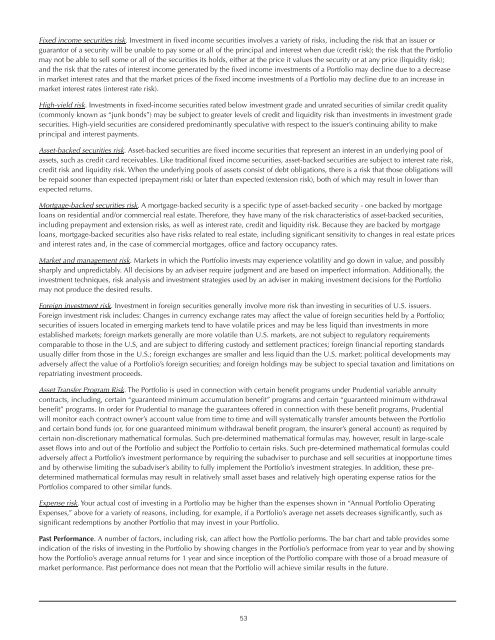Advanced Series Trust AST Academic Strategies Asset ... - Prudential
Advanced Series Trust AST Academic Strategies Asset ... - Prudential
Advanced Series Trust AST Academic Strategies Asset ... - Prudential
You also want an ePaper? Increase the reach of your titles
YUMPU automatically turns print PDFs into web optimized ePapers that Google loves.
Fixed income securities risk. Investment in fixed income securities involves a variety of risks, including the risk that an issuer or<br />
guarantor of a security will be unable to pay some or all of the principal and interest when due (credit risk); the risk that the Portfolio<br />
may not be able to sell some or all of the securities its holds, either at the price it values the security or at any price (liquidity risk);<br />
and the risk that the rates of interest income generated by the fixed income investments of a Portfolio may decline due to a decrease<br />
in market interest rates and that the market prices of the fixed income investments of a Portfolio may decline due to an increase in<br />
market interest rates (interest rate risk).<br />
High-yield risk. Investments in fixed-income securities rated below investment grade and unrated securities of similar credit quality<br />
(commonly known as “junk bonds”) may be subject to greater levels of credit and liquidity risk than investments in investment grade<br />
securities. High-yield securities are considered predominantly speculative with respect to the issuer’s continuing ability to make<br />
principal and interest payments.<br />
<strong>Asset</strong>-backed securities risk. <strong>Asset</strong>-backed securities are fixed income securities that represent an interest in an underlying pool of<br />
assets, such as credit card receivables. Like traditional fixed income securities, asset-backed securities are subject to interest rate risk,<br />
credit risk and liquidity risk. When the underlying pools of assets consist of debt obligations, there is a risk that those obligations will<br />
be repaid sooner than expected (prepayment risk) or later than expected (extension risk), both of which may result in lower than<br />
expected returns.<br />
Mortgage-backed securities risk. A mortgage-backed security is a specific type of asset-backed security - one backed by mortgage<br />
loans on residential and/or commercial real estate. Therefore, they have many of the risk characteristics of asset-backed securities,<br />
including prepayment and extension risks, as well as interest rate, credit and liquidity risk. Because they are backed by mortgage<br />
loans, mortgage-backed securities also have risks related to real estate, including significant sensitivity to changes in real estate prices<br />
and interest rates and, in the case of commercial mortgages, office and factory occupancy rates.<br />
Market and management risk. Markets in which the Portfolio invests may experience volatility and go down in value, and possibly<br />
sharply and unpredictably. All decisions by an adviser require judgment and are based on imperfect information. Additionally, the<br />
investment techniques, risk analysis and investment strategies used by an adviser in making investment decisions for the Portfolio<br />
may not produce the desired results.<br />
Foreign investment risk. Investment in foreign securities generally involve more risk than investing in securities of U.S. issuers.<br />
Foreign investment risk includes: Changes in currency exchange rates may affect the value of foreign securities held by a Portfolio;<br />
securities of issuers located in emerging markets tend to have volatile prices and may be less liquid than investments in more<br />
established markets; foreign markets generally are more volatile than U.S. markets, are not subject to regulatory requirements<br />
comparable to those in the U.S, and are subject to differing custody and settlement practices; foreign financial reporting standards<br />
usually differ from those in the U.S.; foreign exchanges are smaller and less liquid than the U.S. market; political developments may<br />
adversely affect the value of a Portfolio’s foreign securities; and foreign holdings may be subject to special taxation and limitations on<br />
repatriating investment proceeds.<br />
<strong>Asset</strong> Transfer Program Risk. The Portfolio is used in connection with certain benefit programs under <strong>Prudential</strong> variable annuity<br />
contracts, including, certain “guaranteed minimum accumulation benefit” programs and certain “guaranteed minimum withdrawal<br />
benefit” programs. In order for <strong>Prudential</strong> to manage the guarantees offered in connection with these benefit programs, <strong>Prudential</strong><br />
will monitor each contract owner’s account value from time to time and will systematically transfer amounts between the Portfolio<br />
and certain bond funds (or, for one guaranteed minimum withdrawal benefit program, the insurer’s general account) as required by<br />
certain non-discretionary mathematical formulas. Such pre-determined mathematical formulas may, however, result in large-scale<br />
asset flows into and out of the Portfolio and subject the Portfolio to certain risks. Such pre-determined mathematical formulas could<br />
adversely affect a Portfolio’s investment performance by requiring the subadviser to purchase and sell securities at inopportune times<br />
and by otherwise limiting the subadviser’s ability to fully implement the Portfolio’s investment strategies. In addition, these predetermined<br />
mathematical formulas may result in relatively small asset bases and relatively high operating expense ratios for the<br />
Portfolios compared to other similar funds.<br />
Expense risk. Your actual cost of investing in a Portfolio may be higher than the expenses shown in “Annual Portfolio Operating<br />
Expenses,” above for a variety of reasons, including, for example, if a Portfolio’s average net assets decreases significantly, such as<br />
significant redemptions by another Portfolio that may invest in your Portfolio.<br />
Past Performance. A number of factors, including risk, can affect how the Portfolio performs. The bar chart and table provides some<br />
indication of the risks of investing in the Portfolio by showing changes in the Portfolio’s performace from year to year and by showing<br />
how the Portfolio’s average annual returns for 1 year and since inception of the Portfolio compare with those of a broad measure of<br />
market performance. Past performance does not mean that the Portfolio will achieve similar results in the future.<br />
53

















